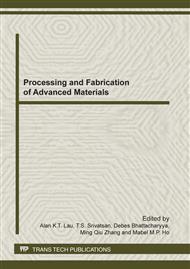[1]
Tamer Ozben, Erol Kilickap, Orhan Cakır, Investigation of mechanical and machinability properties of SiC particle reinforced Al-MMC, J. Mater. Process. Technol., 198 (2008), 574-579.
DOI: 10.1016/j.jmatprotec.2007.06.082
Google Scholar
[2]
El-Gallab, M. Sklad, Machining of Al/SiC particulate metal-matrix composites. Part I. Tool performance, J. Mater. Process. Technol., 83 (1998), 151–158.
DOI: 10.1016/s0924-0136(98)00054-5
Google Scholar
[3]
El-Gallab, M., Sklad, Machining of Al/SiC particulate metal-matrix composites. Part III. Comprehensive tool wear models, J. Mater. Process. Technol., 10 (2000), 10–20.
DOI: 10.1016/s0924-0136(99)00351-9
Google Scholar
[4]
El-Gallab, M. Sklad, Machining of Al/SiC particulate metal-matrix composites. Part IV. Residual stresses in the machined workpiece, J. Mater. Process. Technol., 152(2004), 23–34.
DOI: 10.1016/j.jmatprotec.2004.01.061
Google Scholar
[5]
Li, X., Seah, W.K.H., Tool wear acceleration in relation to workpiece reinforcement percentage in cutting of metal matrix composites, Wear, 2472 (2001), 161–171.
DOI: 10.1016/s0043-1648(00)00524-x
Google Scholar
[6]
Karl U. Kainer, Metal Matrix Composites: Custom-made Materials for Automotive and Aerospace Engineering, Wiley-VCH Verlag GmbH & Co. KGaA, (2006).
DOI: 10.1080/10426910701884301
Google Scholar
[7]
Karl U. Kainer, Metal Matrix Composites: Custom-made Materials for Automotive and Aerospace Engineering, WILEY-VCH Verlag GmbH & Co. KGaA.
DOI: 10.1080/10426910701884301
Google Scholar
[8]
J. Paulo Davima, A. Monteiro Baptista, Relationship between cutting force and PCD cutting tool wear in machining silicon carbide reinforced aluminum, Journal of Materials Processing Technology 103 (2000) 417-42.
DOI: 10.1016/s0924-0136(00)00495-7
Google Scholar
[9]
Oxley P.L.B., The mechanics of machining, Ellis Horwood, Chicester, (1989).
Google Scholar
[10]
G. Boothroyd, W A. Knight, M Dekker, Fundamentals of Machining and Machine Tools, second edition, (1989).
Google Scholar


